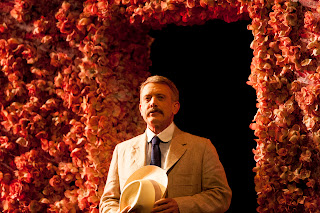 |
| Mr Praed (pronounced 'prayed') - gentleman caller |
 |
| Frank Gardner - the son next door |
 |
| Rev Samuel Gardner - the father next door |
 |
| An innocent introduction: Mrs Warren, Crofts, Vivie Warren |
 | |||
| Sir George Crofts (who ought to be kicked), Vivie |
 |
| Decision |
 |
| Reconciliation? |
 |
| Truth |
 |
| Reality |
Reviewed by Frank McKone
February 27 (matinee)
This is a brilliant production which makes me acutely aware of the skills of the author, the cast and designers. It is especially a triumph for Sarah Giles in her first mainstage production for Sydney Theatre Company.
The actors played exquisitely. While it is understandable, especially because of her final-scene speech and exit, that Helen Thomson receives star recognition as Mrs Warren, which she absolutely deserves, every other actor – Lizzie Schebesta (Vivie Warren), Simon Burke (Praed), Eamon Farren (Frank Gardner), Drew Forsythe (Rev Samuel Gardner) and Martin Jacobs (Sir George Crofts) – matched her precision of expression and language. This is a perfect team for a play which still rings true after 120 years.
The basic designs for set and costumes seem to be based on the photos of the 1902 production by the Theatre of the New Lyric Club, when the official censor finally agreed – to a private club production, as Shaw wrote, “at last, after a delay of only eight years”. (These photos appear in the 1912 Constable publication.)
But how clever and effective it was to make the garden backdrop into a curtain representing a full-height manicured hedge, and to change scenes using a slow-revolving stage which gave us not just a sense of time passing, but time to absorb the effects of the scene just ended. So we were treated to the preservation of the period to which the play belongs, in a frame of modern staging technique.
Despite my long association with the work of Bernard Shaw I had never seen Mrs Warren’s Profession on stage and had wondered how it would work to construct the set as Shaw described it in considerable realistic detail. The creative team of Renée Mulder (designer), with lighting designer Nigel Levings and composer/sound designer Max Lyandvert took the key elements from Shaw, playing with them in the open space of the Wharf 1 theatre and, in doing so, illuminated the relationships between characters more clearly, I believe, than Shaw’s original description would have allowed.
Finally I must explain my enthusiasm for the quality of expression and language in this production. As Alex Lalak states, in one of the excellent essays in the program, “For George Bernard Shaw, the most important things in life were words.” For many directors and actors over the past century, Shaw’s words have seemed a bête noir. There are just so many of them! So much philosophy! How do we act these words?
The answer is to understand that Shaw was using words to both express ideas (of the characters) and expose the relationships between the characters, within a frame of social criticism. Each laugh makes us think; each word tells us how the speaker is thinking and how the receiver of the words is thinking – and feeling – in response.
This is complex work for each actor. This is not ordinary “naturalism”, where a Stanislavsky-style technique of recalled feelings can work. This is writing by an author who is in charge of the effects on us in the audience – on both our thoughts and our feelings. Shaw wrote, in “The Author’s Apology” for Mrs Warren’s Profession, “Give me the critic who has just rushed from my play to declare furiously that Sir George Crofts ought to be kicked.”
And, indeed, this was exactly the effect that these actors and this director achieved for this critic, at least. Further than this, I felt proud that we have in the Sydney Theatre Company practitioners who do such good service to one of the greatest dramatic writers in English since William Shakespeare.
And if you would like to know the source of the director’s note that Shaw stole the play from the famous actress with whom he had worked on Ibsen’s plays, check out A Companion to Modern British and Irish Drama: 1880 – 2005 edited by Mary Luckhurst: “A New Woman Drama” and Mrs Daintree’s Daughter by Janet Achurch – who was a remarkable woman indeed.